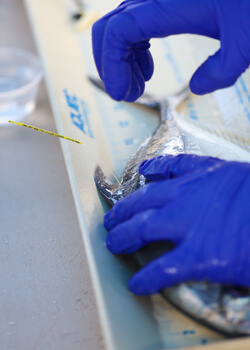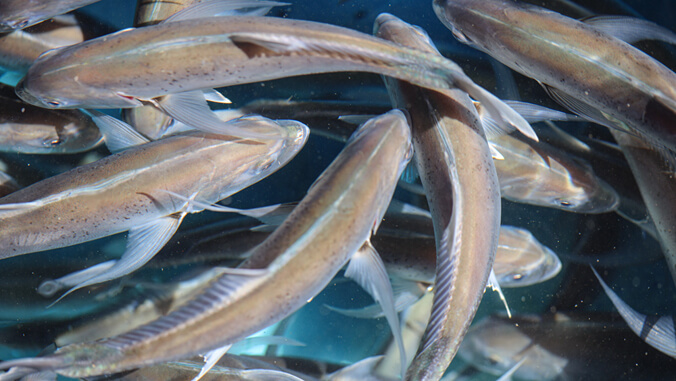About 60 specially raised pāpio (juvenile ulua, or giant trevally) were tagged and released into Maui’s Maʻalaea Harbor by University of Hawaiʻi at Mānoa researchers in February. The scientists want to demonstrate that raising and releasing pāpio can offset fishing pressure and help rebalance the composition of the local reef fish populations. Putting more fish into the ocean also benefits communities by providing increased access to locally produced sustainable seafood.

Pāpio with tag. (Image credit: Maui Ocean Center)
“Due to the great partnership between Hawaiʻi Institute of Marine Biology (HIMB), Maui Ocean Center and Oceanic Institute, we had a very successful tag and release of pāpio on Maui. These collaborations are critical to grow aquaculture within Hawaiʻi for stock enhancement, food production and ecosystem restoration,” said HIMB Associate Research Professor Erik Franklin.
Each tag is labeled with a unique fish identification number and a note with instructions to call and report the date, length, weight, and general capture location of the fish (no need to reveal your secret spots!).
Nanko Fishing Supply is supporting the project with a raffle and prizes for participating fishermen at the end of the recapture period, approximately one year after the release date. The release was part of a research project for Spencer Davis, a Ph.D. student at UH Mānoa’s HIMB.
Oʻahu Pāpio Recaptured
In an earlier phase of the project, about 150 tagged pāpio were released at four different locations around Oʻahu in October: Waikīkī Aquarium, Kāneʻohe Bay, Pūpūkea Marine Life Conservation District and Pōkaʻī Bay. Davis received 21 voluntary recapture reports from fishers from October through December—about a 14% recapture rate. The recaptured fish were from all four Oʻahu release sites.
“One valuable insight we learned from this experience is that these fish almost immediately joined the fishery and became available for fishers to catch. Another valuable insight is that we found some of these fish had traveled as far as eight miles from the release point before being recaptured,” said Davis.

Pāpio. (Image credit: Maui Ocean Center)
The pāpio released on Maui and Oʻahu were raised from eggs collected at the Maui Ocean Center. Franklin, HIMB Research Technician Meredith Pfennig, and UH Mānoa students Leon Tran and Maya Olin all worked on the project. The work was supported by the John and Susan Chun Fund on recreational fisheries research provided to Franklin at HIMB.
Davis said, “I personally am overjoyed that fishers are voluntarily reporting this recapture data, and that we’ve been successful in adding more fish to the fishery to end up on local dinner plates. All reports have said these fish taste great!”



